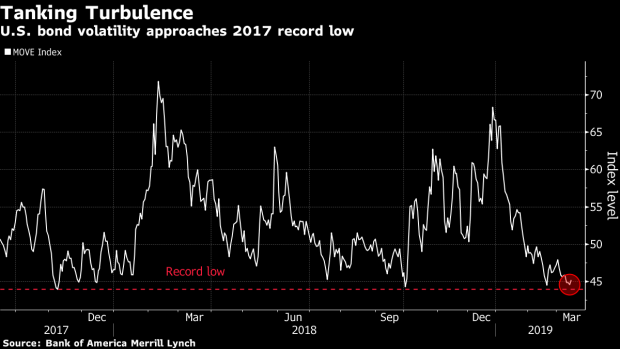(Bloomberg) -- The $15.8 trillion Treasuries market has become exceptionally placid, and volatility-hungry bond traders fear the Federal Reserve’s about to make it even quieter.
Days before Fed policy makers meet, Bank of America Corp.’s MOVE Index continued a recent collapse, falling within a hair of the record low set in 2017. It slumps when traders expect smaller swings in Treasury yields. Things have been so tranquil that in February, yields on 10-year notes moved in an 11.6-basis-point range, one of the narrowest monthly bands ever recorded.
Wednesday’s Federal Open Market Committee decision may only stifle volatility more, warn Morgan Stanley Investment Management and Societe Generale SA. In December, the median projection of policy makers as outlined in the so-called dot plot was for two rate hikes in 2019. Morgan Stanley portfolio manager Jim Caron suspects that’ll be revised this week to just one, with Fed officials reiterating caution about the likelihood of increases -- extending the stupor.
“I believe the Fed will lower their dots and confirm we are in a stable, low-rate environment, with some token risk that the next move may be a hike later this year, which nobody believes,” said Caron, whose firm manages $474 billion. “This is a vol killer.”
A weaker-than-anticipated reading on U.S. industrial activity on Friday boosted Treasuries across the curve, pushing 10-year yields as low as 2.58 percent. But that didn’t persuade traders that the market is about to get exciting. Annualized volatility for three-month options on a 10-year swap fell to a record low of 48.7 basis points.
Volatility has cratered across asset classes as a darkening global growth outlook spurs developed-nation central banks from the European Central Bank to the Bank of Canada to dial back plans to dial back expectations for their economies. The “total transparency provided by central banks, especially the Fed,” has caused the low-volatility regime, according to Credit Agricole strategist Alex Li.
Societe Generale’s Subadra Rajappa expects yields to keep going sideways. She sees the 10-year yield staying between 2.5 percent and 2.8 percent through the end of 2019. While there’s a risk that the Fed could come across as even more dovish than market watchers anticipate on Wednesday, that would likely spark only limited turbulence, she said.
“Treasuries are rich to fundamentals, but with near-term uncertainties like Brexit and China trade negotiations, it’s hard to see a selloff,” said Rajappa, head of U.S. interest rates strategy at SocGen. “If we go from two hikes to no hikes, that might spook the markets and cause a rise in vol, but such a rise is likely to be short-lived.”
What to Watch
- The week’s main event is March 20, with the Federal Reserve’s interest-rate decision, new economic forecasts and Chairman Jerome Powell’s post-meeting press conference
- Here’s the calendar for U.S. economic releases
- March 18: NAHB housing market index
- March 19: Factory, durable goods and capital goods orders
- March 20: Weekly mortgage applications
- March 21: Jobless claims; Philadelphia Fed index; Bloomberg consumer comfort; Conference Board Leading Index
- March 22: Markit manufacturing and services PMIs; wholesale inventories; existing home sales; Treasury’s monthly budget statement
- Treasury will auction bills and TIPS this week
- March 18: 3- and 6-month bills
- March 21: 4- and 8-week bills; 10-year TIPS reopening
--With assistance from Elizabeth Stanton.
To contact the reporter on this story: Katherine Greifeld in New York at kgreifeld@bloomberg.net
To contact the editors responsible for this story: Benjamin Purvis at bpurvis@bloomberg.net, Nick Baker
©2019 Bloomberg L.P.








